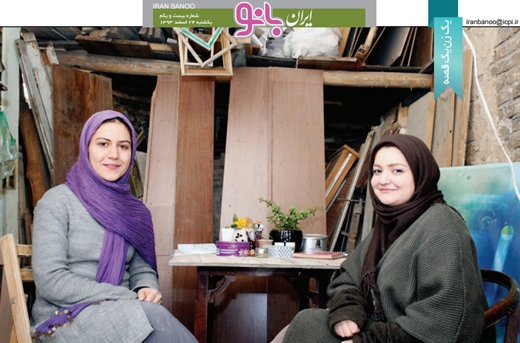A real-life story of women who have dared to venture into a male-dominated field and prove themselves; a story of new challenges and opportunities for two female woodworkers recounted by Akram Ahmadi in Iranbanou, a supplement of Iran newspaper.
The following is a partial translation of a “One Story, One Woman” report in the supplement’s 21st issue (March 15, 2015):
A narrow alley in the middle of an old street is home to seven carpenter shops which have iron doors, no windows and a stack of uncut and unshaped wood, with the sound of chainsaw and air compressor and the smell of paint filling the air.
They are seven old carpentries, but there are new carpenters in one of them; two young women who have changed the mood in the alley. They have placed primrose plants on their table, have tea and sugar storage boxes which are pink with flowery patterns, use red glasses and wear white gloves.
The alley gets cleaned as the pair opens the door of their workshop every day. They sweep the area first thing in the morning, greet their neighbors and then open the shutters and pick up saw and sandpaper to do woodworking.
Negin Nasiri and Shaghayegh Jahanbani are now the familiar carpenters of the alley which is home to [master] carpenters. The two graduates of visual arts used to be journalists, but they have set up shop as carpenters and run their own business.
[…]
Strange carpenters
Shaghayegh says, “There are six other carpentries in this alley. Their owners looked at us with surprise when we were new in the job. They were all old, well-experienced carpenters, wanting to know what we were up to. Their mindset changed when they saw how serious we are going through our paces. Now they all help us. […] They are now accustomed to our presence here. We are now like them, no difference.”
We relish working here
“Here is the place where the action is. It is the place where you enjoy working and get concerned about it.” This is what Shaghayegh said about her preoccupation with the job. […]
“What is interesting for me is producing a new thing. When a table is painted, I become overjoyed thinking that I have made it. […]”
“A feminine look prevails in this place. The old, antique devices play the leading role here.” Negin says about her interest in old works, “Our works fall into two parts: One is about the old, antique works which we renovate. […] The other is related to the orders we take to make new devices. In other words, we should create a new thing. […]
“Since day one, we started to write down our memories which are mostly about how people treat us. In the early days of our business, people used to address us as sirs whenever they walked past our shop. But we turned back, they would say, ‘Do we have female carpenters [in this country]?’ But the reaction of women was different. They would become excited seeing women in this job. Our neighbors would say, ‘The atmosphere has been lightened.’ […]”
A carpenter who has studied art produces different works. S/he employs colors which had been absent in decorations.”
Negin speaks about the footprints of nature and its colors in their works, “[…] The soup your mom cooks is a mix of green and red; a color which looks natural and pleasant. That’s why we use the colors which are always present [in our surroundings], but nobody can think of them as being evident in furniture coverings. […]”
[…]
Art studio
“There is one dreamy, fixed point for any start: what is to be done and what the goal is.” Negin says about her ideals, “I wish to have an art studio. I want to gather a group of people and do the things which are believed to be impossible […]
“Currently, what we’ve done has been seen by others. We’ve been asked to do the interior designing of an auditorium of a residential tower. That is a big step for us. We seek to take our art into people’s lives. […] We need to stay the course. We have lots of things to do. We need to get the show on the road after Nowruz holiday.”
